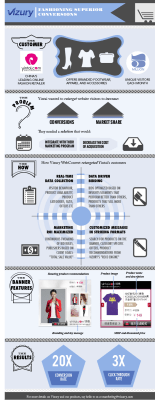Vizury, a Bangalore-based ad retargeting startup, is in talks with investors to raise an additional $20 million by March this year, with existing backer Inventus leading the round, according to sources familiar with the company.
The Series C investment is being done reportedly at a $60 – $70 million valuation — perhaps low-sounding to a Silicon Valley ear, but a typical figure for an ad tech company of this size in India. As a point of comparison, rival Criteo is currently valued at $1.86 billion.
The financing will be used to expand aggressively in China and Japan, Vizury’s co-founder Chetan Kulkarni said in an interview.
Kulkarni would not share current revenue details for Vizury, but he said the company helps generate $300-$400 million in annual sales for its customers including Virgin Airlines and Chinese e-commerce company Yintai. Vizury is likely to raise one more round before it goes public, expected in about a year’s time.
Vizury has already raised $11 million in funding, including a $9 million Series B round in October 2012 from Nokia Growth Partners, Ojas Venture Partners and Inventus Capital Partners. The startup had raised Series A funding of $2 million from Ojas Venture Partners and Inventus in November 2010.
This upcoming Series C round will likely be the last but one round of funding for Vizury before it lists on an exchange in about an year’s time.
Vizury is among a bunch of fast growing Indian adtech companies such as InMobi and Komli Media that are beginning to take on global rivals including Google.
Companies such as Criteo and Vizury are seeing huge growth in business from e-commerce customers who want to woo back their online visitors. These startups target ads at people who visit e-commerce sites but move on before buying anything. Retargeting means that when they visit other sites, they will continue to see ads for products from those e-commerce sites. Vizury’s online ad platform now counts around 500 million monthly users.
While online advertising continues to grow, there is an increasing emphasis on more sophisticated technology to make sure that the investments being made in it are providing the best returns, by making sure to match ads better with people who will be most receptive to them.
InMobi showed signs of its ambitions to go beyond just being a mobile ad network when it acquired Overlay Media in January last year to improve ad personalization, after raising some $200 million from SoftBank. Komli Media has raised around $97 million in funding so far from investors including Norwest Venture Partners, Nexus Venture Partners, Helion Venture partners and Draper Fisher Jurvetson.
“We’ll invest in building local products for markets like China, because that’s the only way it can become a billion dollar market,” Kulkarni told Techcrunch. China currently contributes around 20% of Vizury’s business, but Kulkarni aims to make the country contribute nearly half of its total revenue within next few years.
Vizury, which also counts Chinese online travel agency Ctrip among its top clients, currently generates annual revenues of about $20 million, according to one of the potential investors. The startup’s closest rival is French ad retargeting company Criteo, which raised $251 million after its IPO on NASDAQ last year.
Kulkarni of Vizury, who co-founded the startup along with Gourav Chindlur and Vikram Nayak in December 2008, said he will evaluate options to IPO in about 18 months.
“We could consider a listing in Hong Kong apart from the U.S., especially given Vizury’s growth ambitions in Asia,” he said.
Vizury, and other adtech startups are also betting on a growing base of mobile users in markets such as China, India and Japan. India’s online marketplace Snapdeal, which is backed by eBay, is seeing mobile users account for over 30% of its total traffic. Around 20% of the traffic that visits Flipkart, India’s biggest e-commerce site, comes from mobile devices.
“Despite this growth in mobile traffic, the key question is how much of this actually converts into sales. And that’s where we are seeing divergent trends–sales conversions on mobile are lower in India when compared with those in China for instance,” Kulkarni said.
